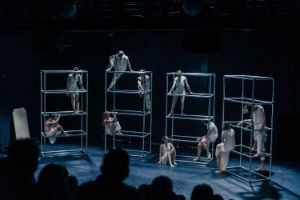Treffen junge Szene
Dance
Mindcage
ARS SALTANDI Company
Ars Saltandi e. V., Hildesheim, Lower Saxony

Mindcage © Christian Giraldo
As a self-initiated group, we set out to create our own stage production. Kaspar, Amelie, and Laura voluntarily took on the role of choreographic direction. Together, we chose a central theme as our starting point, which became the red thread running through our piece: “Mindcage” means the imprisonment within one’s own mind. Where are our limits, and what holds us back? We explore the mental barriers we all face, not only as individuals but also together as a group navigating the chaos of our thoughts.
Through improvisation and open exchange, we developed shared movement sequences. Our choreographies grew out of emotions and themes that we explored through dialogue. What makes our group special is the way diverse ideas and strengths came together to form a cohesive whole. Everyone had the opportunity to contribute and be part of the process. The group thrives on mutual learning and inspiration.
We are eleven young dancers between the ages of 16 and 21, each with around ten years of dance experience. We met at our dance school, Ars Saltandi Dance & Drama School. Within the school’s association, various volunteer groups regularly take part in performances and bring a wide range of choreographic works to the stage. Through years of shared training, we’ve grown into a second family.
Jury Statement by Lin Verleger
Who doesn’t know the feeling? Endless spirals of thought, invisible boundaries in our minds that hold us back and hinder our growth. The piece “Mindcage” makes these inner barriers and mental processes physically tangible through an intense choreographic exploration and a striking stage design. Initiated by the ARS SALTANDI Company, this collective work began with questions around internal limitations—and the paths that lead to freedom.
What emerged from this visibly collaborative process—guided by three creative minds, rooted in flat hierarchies and marked by strong initiative—is a visually powerful and emotionally charged piece that draws the audience into the dancers’ search for liberation.
Between isolation and connection, a path unfolds—from confinement to breakthrough. Boundaries are questioned, confronted, overcome, and redefined. This internal struggle bursts forth in a field of tension shaped by anger, fear, despair, and pressure—and collides with a deep longing for freedom, self-determination, and release from the mental cage.
From the very first moment, the audience is captivated. What we witness is a dynamic, committed group of dancers who remain individually distinct even in moments of collective strength. They perform with a strong sense of awareness and technical precision—whether in duets, trios, solos, or as an ensemble. It is clear they have something to say—and they do so with full conviction. This determination resonates with the audience—physically, emotionally, intellectually.
Clear focus, a convincing dramaturgical arc, and a palpable sense of trust within the group carry the piece. Particularly impressive is the creative use of the central stage element—the “Mindcage”—which is repeatedly deconstructed as the piece unfolds.
The work stands out through its choreographic density, powerful visual metaphors, and intelligently constructed stage formations. Acrobatic elements are seamlessly integrated—not for spectacle, but to serve the theme. They create genuine moments of awe without overshadowing the content, supporting the performers’ joy in movement and depth of expression.
“Mindcage” remains layered throughout: highs and lows, emotional intensity, and raw vulnerability allow the audience to engage deeply. The work never becomes superficial or predictable. Instead, it opens a wide space for interpretation—anchored in a clear concept and executed with honesty, precision, and artistic courage.
“Mindcage” is a strong, well-constructed, and thematically as well as choreographically compelling work—one that fully deserves its invitation to this year’s Tanztreffen der Jugend. Because it reminds us that we can break free from the cages in our minds—that freedom is something we carry within us, and that the first step lies in our own hands.
In that spirit: “Feel the fear and do it anyway!”
With
Thea Bentz, Kaspar Blohmer, Amelie Evers, Emil Henke, Paul Henke, Maurin Katholnigg, Phineas Katholnigg, Emma Könneker, Lisa Marie Mann, Khira Scharf, Laura Voronovic
Katrin Katholnigg, Peter Katholnigg – technique